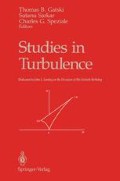Abstract
We perform numerical experiments on natural and controlled transition in two types of shear flows: a periodic ulated flat plate. In the mixing-layincompressible mixing layer, and a supersonic (Mach 5) boundary layer developing on an inser case, a direct-numerical simulation is developed, starting with a hyperbolic-tangent velocity profile. When the flow is forced initially by a small 3D isotropic residual turbulence (natural transition), it develops a vortex-lattice structure of the Kelvin-Helmholtz billows: this subharmonic secondary instability, corresponding to the helical-pairing instability studied by Pierrehumbert and Widnall (J. Fluid Mech., 114, pp 59-82, 1982), is in our calculation more amplified than the two-dimensional pairing. This is at variance with the predictions of the secondary instability theory, and yields a highly three- dimensional structure of the flow. A quasi two-dimensional perturbation (controlled transition), on the contrary, leads to longitudinal hairpin vortices strained between quasi two-dimensional billows, as found in the laboratory experiments of Bernal and Roshko (J. Fluid Mech., 170, pp 499-525, 1986). The compressible turbulent boundary layer at Mach 5 is numerically out of reach if one restricts to direct-numerical simulations. We have developed a large-eddy simulation using eddy-coefficients based on the second-order structure function of the velocity. This allows us to have a controlled-transition experiment, where the flow is forced upstream by a set of two-dimensional waves (second mode), to which a small 3D. Unitè Mixte de recherché CNRS, Institut National Polytechnique de Grenoble, Universitè Joseph Fourier. This work was supported by D.R.E.T. under contract 88/150, by CNES/Avions Marcel Dassault (HERMES European Space Programme), and by GDR-CNRSMécanique des Fluides Numérique. Part of the calculations were done on a grant of the Centre de Calcul Vectoriel pour la Recherche.
Access this chapter
Tax calculation will be finalised at checkout
Purchases are for personal use only
Preview
Unable to display preview. Download preview PDF.
References
Bernal, L.P. and Roshko, A., 1986, “Streamwise vortex structure in plane mixing layers”, J. Fluid Mech., 170, pp 499 – 525.
Breidenthal, R., 1981, “Structure in turbulent mixing layers and wakes using a chemical reaction”, J. Fluid Mech., 109, pp 1 – 24.
Browand, F.K. and Troutt, T.R., 1980, “A note on spanwise structure in the two-dimensional mixing layer” J. Fluid Mech., 93, pp 325 – 336.
Browand, F.K., Ho, C.M., 1983, “The mixing layer: an example of quasi two-dimensional turbulence”, inTwo-dimensional turbulence, J. Mec. Theor. Appl., Suppl., R. Moreau ed., pp 99–120
Chorin, A.J., 1986, “Turbulence and vortex stretching on a lattice”, Comm. Pure and Appl. Maths, XXXIX, pp S47–S65.
Comte, P., 1989, Etude par simulation numérique de la transition a la turbulence en ecoulement cisaillé libre, These de l’ Institut National Poly- technique de Grenoble.
Comte, P., Lee, S.S., Cabot, W. and Moin, P., 1990, “A subgrid-scale model based upon the second-order velocity structure function”, Proc. Summer program 1990, Center for Turbulence Research, Stanford, California.
Fiedler, H.,1990, private communication.
Fouillet, Y.,1990, private communication.
Gottlieb, D., Turkel, E., 1976, “Dissipative two-four methods for time-dependent problems”, Math. Comp., 30, pp 703–723
Kraichnan, R.H., 1976, “Eddy viscosity in two and three dimensions”, J. Atmos. Sci., 33, pp 1521–1536
Lasheras, J.C., Choi, H., 1988, “Three-dimensional instability of a plane free shear layer: an experimental study of the formation and evolution of streamwise vortices”, J. Fluid Mech., 189, pp 53–86
Lesieur, M., 1990, Turbulence in Fluids(second revised edition), Kluwer Publishers, Dordrecht.
Lesieur, M., Staquet, C., Le Roy, P., Comte, P., 1988, “The mixing layer and its coherence examined from the point of view of two- dimensional turbulence”, J. Fluid Mech., 192, pp 511–534
Leslie, D.C., Quarini, G.L., 1979, “The application of turbulence theory to the formulation of subgrid modelling procedures”, J. Fluid Mech., 91, pp 65–91
Lumley, J.L., 1989, inWither turbulence? Turbulence at the crossroadsSpringer Verlag Lecture Notes in Physics, 357, pp 49–57, J. Lumley, ed
Meiburg, E., 1985, PhD thesis, University of Karlsruhe.
Metais, 0., Lesieur, M., 1990, “Spectral large-eddy simulations of isotropic and stably-stratified turbulence”, submitted to J. Fluid Mech.
Normand, X., 1990, Transition à la turbulence dans les écoulements sisaillés libres ou pariètaux, Thèse de l’lnstitut National Polytechnique de Grenoble.
Normand, X., Lesieur, M., 1990, “Numerical experiments on transition in the compressible boundary layer over an insulated flat plate”, Theor. Comp. Fluid Dynamics, in press.
Pierrehumbert, R.T. et Widnall, S.E., 1982, “The two and three- dimensional instabilities of the spatially periodic shear layer”, J. Fluid Mech., 114, pp 59–82
Silveira Neto, A., Grand, D., Metais, 0., Lesieur, M., 1990, “Large- eddy simulation of the turbulent flow in the downstream region of a backward-facing step”, submitted to Phys. Rev. Letters.
Yakhot, V., Orszag, S., 1986, “Renormalization Group (RNG) methods for turbulence closure”, J. Scientific Computing, 1, pp 3–52
Author information
Authors and Affiliations
Editor information
Editors and Affiliations
Rights and permissions
Copyright information
© 1992 Springer-Verlag New York, Inc.
About this chapter
Cite this chapter
Lesieur, M., Comte, P., Normand, X. (1992). The Vortex-Lattice Structure of Turbulent-Shear Flows. In: Gatski, T.B., Speziale, C.G., Sarkar, S. (eds) Studies in Turbulence. Springer, New York, NY. https://doi.org/10.1007/978-1-4612-2792-2_32
Download citation
DOI: https://doi.org/10.1007/978-1-4612-2792-2_32
Publisher Name: Springer, New York, NY
Print ISBN: 978-1-4612-7672-2
Online ISBN: 978-1-4612-2792-2
eBook Packages: Springer Book Archive

